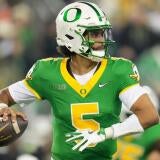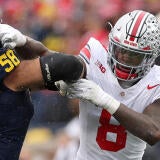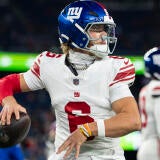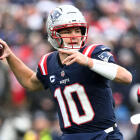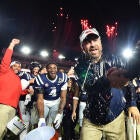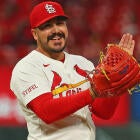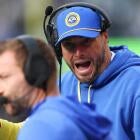2022 NFL Draft: Buyer beware on Travon Walker, Jermaine Johnson and these other top prospects
Despite being highly touted and likely top picks, these draft prospects are risky propositions

We won't know this right away, but early in the 2022 NFL Draft, a small collection of picks will get selected much too early. Happens in every single draft class.
To warn you about who those prospects may very well be, I write this "Buyer Beware" piece every draft season.
Buyer Beware prospects in the past include: Gregory Rousseau, Kadarius Toney, Odafe Oweh, and Patrick Surtain in the 2021 class; Derrick Brown, D'Andre Swift, Kenneth Murray, and -- gulp -- Justin Jefferson in 2020; and Dwayne Haskins, Mack Wilson, Jaylon Ferguson, Josh Jacobs, Rashan Gary, and Jacksonville's Josh Allen in the 2019 draft.
While I'm not insinuating these prospects are guaranteed to bust, they're just the most risky propositions who could still land somewhere in the first round or very early on Day 2. In my estimation, they'll have a difficult time living up to their draft positions. These are my "buyer-beware" prospects in the 2022 class.
Travon Walker, EDGE, Georgia
Why: Lack of pass-rushing moves; minimal bend
At 6-foot-5 and 272 pounds with arms over 35 inches long and a tremendous, all-around combine workout to his name, Walker appears like a justifiable top-five selection and someone with a strong likelihood of becoming a monstrously productive pro.
On the field, his game is reminiscent of a prospect who should be picked much later and is in need of substantial technical maturation before he can become an effective NFL player.
Despite his 6.89 three-cone time -- scintillatingly fast for someone of his height and weight -- Walker is noticeably stiff around the corner, which is essentially the cardinal sin of rushing the quarterback from the outside. It's exceptionally rare for an inflexible defensive end to morph into a star in the NFL. If that type of player does beat the odds, he's typically a pass-rush move genius. Unfortunately for Walker, he's not that, either.
Against the run, the Georgia specimen uses his length to his advantage to dispatches blocks on a regular basis. When he's attacking upfield, the effective, powerful hand work is almost nonexistent.
Sure, Kirby Smart did ask Walker to read and react instead of just putting his head down and flying into the backfield like other edge rushers in this class, but I would be very hard-pressed to pick someone at that position who didn't have vast experience attacking the quarterback in a traditional sense in college.
Walker has major upside, no doubt. The athleticism at his size screams that. But he doesn't possess two of the most foundational elements needed to get after the quarterback. He's extraordinarily risky.
Devin Lloyd, LB, Utah
Why: Limited coverage experience/expertise
Lloyd's film is an experience. You have to buckle in before watching. He's long, hyperactive, and strikes at all segments of the field as a run defender. From a physical perspective, Lloyd is that dude.
He just didn't get nearly as much experience in coverage as I'd like for a first-round or potentially even top-20 selection. More often than not, Utah deployed him in a Micah Parsons-esque edge-rusher role in obvious passing situations. And while Lloyd generated the occasional pressure in that side job, he's not in the same stratosphere as the Cowboys' Parsons in terms of outside pass-rush ability. I don't even view him as that great of a blitzer despite his explosiveness and power.
When Lloyd was asked to cover, he was fluid and instinctive; he'll just have to learn how to become productive in that area on the fly in the NFL. And when an NFL offensive coordinator knows a young linebacker is green in coverage, the game plan can often revolve around exploiting the youthful second-level defender in coverage. Ask 2020 first-round picks Kenneth Murray -- very similar physically to Lloyd -- Jordyn Brooks and Patrick Queen.
Lloyd's run-defending brilliance will keep him on the field, as he'll be an asset in that regard. The coverage naivety concerns me at the outset of his pro career.
Jermaine Johnson, EDGE, Florida State
Why: Stiffness around the corner, inconsistent hand work, lacking burst
Much of what is true about Walker pertains to Johnson. And it's not to suggest outside rushers lacking bendiness and/or pass-rush moves are incapable of becoming success stories at the NFL level.
They're just gambles I'd much rather take in Round 2, much less inside the top half of the first round.
For Johnson, there is more hope for his professional productivity than Walker because he does know how to use his hands as weapons as a classic outside pass rusher, and there's a noticeable speed-to-power conversion to his game on film.
What Johnson's hand work boasts in effectiveness, it lacks in consistency. He simply doesn't use his pass-rushing maneuvers enough. Many of his rushes simply stall out upon first contact, a strange coincidence because Johnson can really bring it with his long-arm bull rush.
In face-up scenarios, Johnson thrives, because that's when his power is accentuated. When he has to rush around the corner, his burst and hip and ankle tightness are apparent. He's not a fly-around-the-edge type. Now, maybe he can win heads-up with tackles on a consistent basis because the length and pop are both there. I'd simply need a top-15 pick at the edge-rusher spot to have more bend/dip capabilities than Johnson, particularly if his pass-rush plans were hit-or-miss.
Trent McDuffie, CB, Washington
Why: Super-short arms, lacking collegiate production
Is McDuffie twitchy? Absolutely. Is he the twitchiest cornerback prospect I've scouted? No. And that vital attribute to playing the cornerback position is widely believed to be his greatest strength. While the NFL has gradually shifted from size and physicality to suddenness and route-running chops as the most vital attributes at receiver, for being a No. 1 cornerback, McDuffie severely lacks length. His 29 3/4-inch arms placed in the fifth percentile among cornerbacks at the combine since 1999.
Related to that -- McDuffie had just two picks and eight pass breakups in three seasons as a full-time player for the Huskies.
Yes, the Washington scheme is nearly a zone-only coverage system in which everything is kept in front of the outside corners, but no matter how you shake it, McDuffie was minimally productive for someone who was tasked with watching the quarterback through the receiver's route on nearly every pass play.
And I don't believe "zone cornerback" needs to have a negative connotation. Playing zone effectively is challenging in its own ways, different from man. McDuffie reminds me a lot of fellow Washington defensive back prospect Byron Murphy, who was hyped as a potential mid first-round prospect, ultimately was the first selection in Round 2, and has not met expectations with the Cardinals.
McDuffie does have quality traits. No doubt. I didn't see them as first-round caliber. His short arms limit his pass-breakup radius, and he wasn't a big-time playmaker in college. All that makes him pretty risky for someone being touted as the potential second cornerback off the board in the first round.


